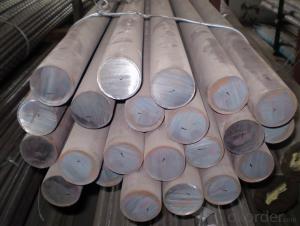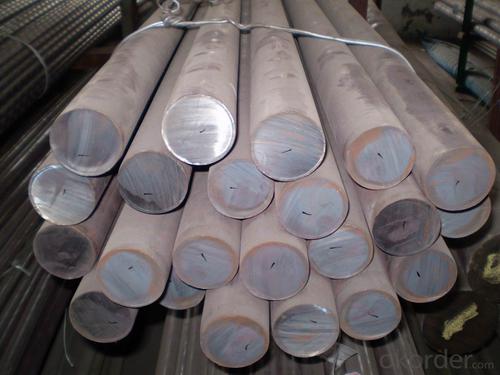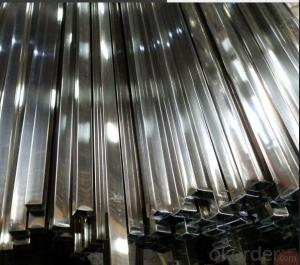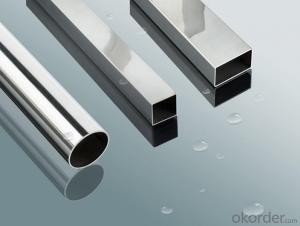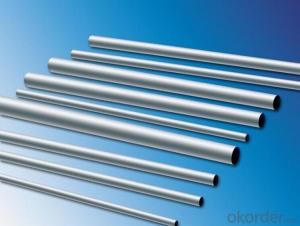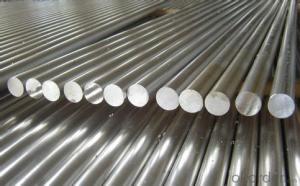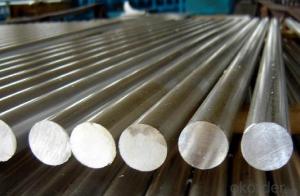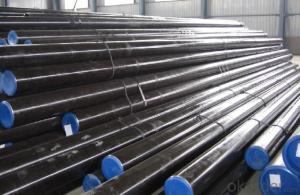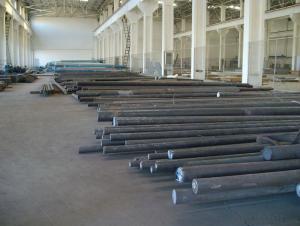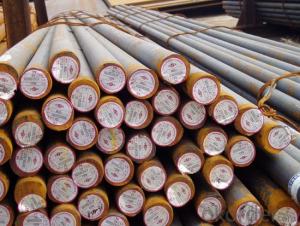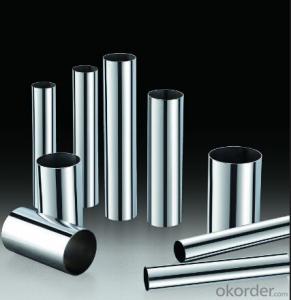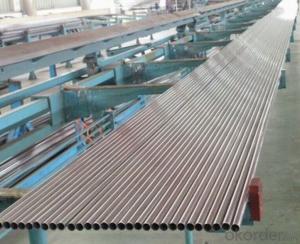Top quality stainless steel bright round bar 316L 630 2205
- Loading Port:
- Tianjin
- Payment Terms:
- TT OR LC
- Min Order Qty:
- 100 kg
- Supply Capability:
- 1000 kg/month
OKorder Service Pledge
Quality Product, Order Online Tracking, Timely Delivery
OKorder Financial Service
Credit Rating, Credit Services, Credit Purchasing
You Might Also Like

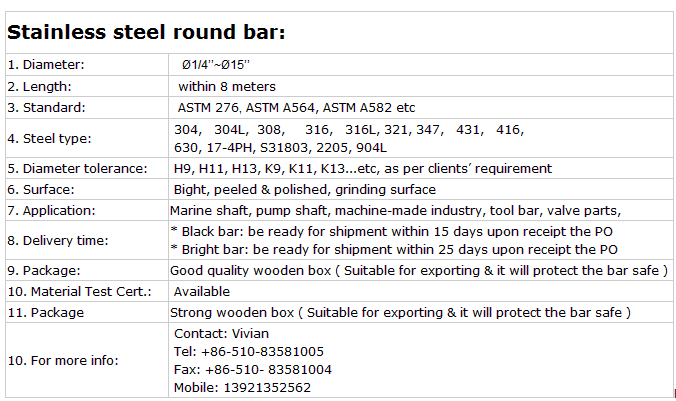
- Q: Can stainless steel pipes be used for desalination systems?
- Indeed, desalination systems can utilize stainless steel pipes. This material, known for its resistance against corrosion, can withstand the demanding conditions present in desalination processes, wherein salt and other impurities are extracted from seawater. The exceptional corrosion resistance of stainless steel renders it a prime selection for conveying the treated water, as it aids in preserving the water's purity and preventing any contamination. Furthermore, stainless steel pipes possess commendable mechanical attributes, such as strength and durability, which are indispensable for the effective operation of desalination systems.
- Q: What brand of stainless steel pipe cutting machine is good?
- That choose the cutting way, to me the tool pipe cutting manner is also a very good method, small caliber selection automatic instrument lathe, large caliber SOONFAN anti vehicle type cut pipe (pipe does not turn the rotary knife type), of course, saw blade, saw blade, laser, plasma and other methods can be used, for example to decide according to their own conditions for pipe cutting.
- Q: What is the difference between electropolished and passivated stainless steel pipes?
- Both electropolished and passivated stainless steel pipes are utilized as surface treatments in order to enhance the corrosion resistance and aesthetic appearance of stainless steel. Nevertheless, there exist notable distinctions between the two procedures. Electropolishing serves as an electrochemical method which selectively eradicates a minute layer of material from the surface of the stainless steel. This process aids in eliminating impurities, contaminants, and embedded particles, thereby resulting in a sleek and pristine surface. Furthermore, electropolishing enhances the microfinish of the stainless steel, thereby reducing surface roughness and elevating the overall appearance. It also augments the corrosion resistance of stainless steel by fostering the formation of a passive chromium oxide layer on the surface. Conversely, passivation is a chemical process that involves the application of an acid-based solution onto the surface of the stainless steel. This solution assists in eliminating iron contaminants and other foreign substances from the surface, leaving behind a spotless and passive layer of chromium oxide. Passivation serves to enhance the corrosion resistance of stainless steel by promoting the creation of a stable and protective oxide layer. In conclusion, electropolishing represents an electrochemical approach that eradicates a thin layer of material, thereby generating a smooth and pristine surface, whereas passivation constitutes a chemical process that eliminates contaminants and encourages the development of a safeguarding oxide layer. Both procedures contribute to heightening the corrosion resistance and aesthetics of stainless steel pipes, although they differ in the methodologies employed to achieve these outcomes.
- Q: What are the different types of stainless steel pipe connections?
- There are several different types of stainless steel pipe connections that are commonly used in various applications. Some of the most common types include: 1. Threaded Connections: These connections involve screwing together two pipes with matching threads. They are commonly used for smaller pipe sizes and low-pressure applications. 2. Socket Weld Connections: In this type of connection, the pipe is inserted into a socket and then welded around the joint. Socket weld connections are mainly used for smaller pipe sizes and high-pressure applications. 3. Butt Weld Connections: Butt weld connections involve welding the ends of two pipes together. They are commonly used for larger pipe sizes and high-pressure applications. 4. Flanged Connections: Flanged connections involve attaching two pipes together with a flange on each end. The flanges are then bolted together to create a secure joint. Flanged connections are commonly used for larger pipe sizes and applications requiring easy disassembly. 5. Compression Connections: Compression connections involve using a compression fitting to connect two pipes. This type of connection is particularly useful for applications that require frequent disassembly and reassembly. 6. Grooved Connections: Grooved connections involve using grooved fittings to connect two pipes. The grooves on the fittings are matched with grooves on the pipes, and then a gasket is inserted to create a seal. Grooved connections are commonly used in fire protection systems and industrial piping. Each type of stainless steel pipe connection has its own advantages and disadvantages, and the choice depends on the specific requirements of the application. It is important to consider factors such as pressure, temperature, pipe size, and ease of installation when selecting the appropriate connection type.
- Q: What is the cost difference between stainless steel pipes and other materials?
- The cost difference between stainless steel pipes and other materials can vary depending on various factors such as the type of material being compared, the size and specifications of the pipes, and the current market conditions. In general, stainless steel pipes tend to be more expensive than other materials such as PVC, copper, or galvanized steel. This is primarily due to the higher production and raw material costs associated with stainless steel, as well as its superior qualities and durability. Stainless steel pipes offer numerous advantages over other materials, including excellent corrosion resistance, high strength, and the ability to withstand extreme temperatures. These qualities make stainless steel pipes ideal for various applications, especially in industries such as oil and gas, chemical processing, and water treatment. While stainless steel pipes may have a higher upfront cost, they often provide long-term cost savings due to their extended lifespan and reduced maintenance requirements. Additionally, the higher initial investment in stainless steel pipes can be justified by considering the potential costs associated with pipe failures, leaks, or replacements that may occur with other materials. It is important to note that the cost difference between stainless steel pipes and other materials can vary significantly depending on the specific project requirements and market conditions. Therefore, it is advisable to consult with suppliers, contractors, or industry professionals to obtain accurate and up-to-date pricing information for a specific application.
- Q: What are the different types of stainless steel pipe insulation?
- On the market, you can find various stainless steel pipe insulation options. These options differ in terms of their material composition, construction, and insulation properties. One popular option is fiberglass insulation, which involves wrapping a layer of fiberglass material around the stainless steel pipe. This type of insulation is known for its exceptional thermal insulation properties and its ability to withstand high temperatures. It is also resistant to moisture, making it suitable for both indoor and outdoor use. Another option is foam insulation, which is made from a foamed plastic material like polyurethane or polystyrene. Foam insulation is lightweight, easy to install, and provides good thermal and acoustic insulation. It is commonly used in residential and commercial buildings to insulate hot water pipes and HVAC systems. Additionally, there are elastomeric insulation materials, which are flexible rubber-like materials that can be easily wrapped around the stainless steel pipe. These materials are recognized for their excellent thermal insulation properties and their ability to resist moisture and condensation. Elastomeric insulation is frequently used in refrigeration and air conditioning systems. Lastly, there are pre-insulated stainless steel pipe systems, which come with a layer of insulation material already applied to the stainless steel pipe. This type of insulation is commonly used in industrial applications where thermal insulation is critical, such as in chemical plants or oil refineries. To sum up, the available options for stainless steel pipe insulation include fiberglass insulation, foam insulation, elastomeric insulation, and pre-insulated pipe systems. The choice of insulation type depends on factors such as the specific application, desired insulation properties, and budget.
- Q: Can stainless steel pipes be sandblasted?
- Yes, stainless steel pipes can be sandblasted. Sandblasting is a common method used to clean or prepare the surface of stainless steel pipes by propelling fine particles at high speeds to remove contaminants or create a rough texture for better adhesion of coatings.
- Q: What is the difference between 304 and 304H stainless steel pipes?
- The main difference between 304 and 304H stainless steel pipes lies in their carbon content. While both materials are made up of the same elements, including iron, chromium, and nickel, 304H stainless steel contains a higher carbon content compared to 304 stainless steel. The increased carbon content in 304H provides improved high-temperature strength and creep resistance, making it more suitable for applications that involve elevated temperatures. Because of its higher carbon content, 304H stainless steel pipes have better resistance to sensitization during welding, which is the formation of chromium carbides at the grain boundaries. This can lead to intergranular corrosion and reduced mechanical properties. By incorporating a higher carbon content, 304H stainless steel pipes can resist this sensitization phenomenon and maintain their structural integrity even at high temperatures. In terms of other properties, both 304 and 304H stainless steel pipes offer excellent corrosion resistance, good weldability, and high strength. They are widely used in various industries such as oil and gas, chemical, food processing, and pharmaceuticals. However, it is important to note that 304H stainless steel pipes are typically recommended for applications requiring high-temperature strength, while 304 stainless steel pipes are more commonly used for general-purpose applications. In summary, the difference between 304 and 304H stainless steel pipes lies in their carbon content. 304H stainless steel pipes have a higher carbon content, providing improved high-temperature strength and resistance to sensitization during welding. It is important to consider these differences when selecting the appropriate stainless steel pipe for a specific application.
- Q: What are the different grades of stainless steel pipes?
- There is a variety of stainless steel pipe grades available, each possessing its own distinct properties and applications. The most commonly utilized grades are as follows: 1. Grade 304: This stainless steel grade is widely employed in pipe manufacturing due to its exceptional corrosion resistance, heat resistance, and high strength. It is suitable for a diverse range of uses, including water pipes, food processing equipment, and architectural structures. 2. Grade 316: Renowned for its superior corrosion resistance, especially in environments with high chloride content, Grade 316 pipes are frequently utilized in marine applications, chemical processing plants, and medical equipment where protection against pitting and crevice corrosion is vital. 3. Grade 321: This grade is fortified with titanium, rendering it resistant to intergranular corrosion after exposure to elevated temperatures. Grade 321 pipes are commonly employed in applications involving high temperatures, such as exhaust systems, furnace components, and heat exchangers. 4. Grade 409: Specifically engineered for high-temperature applications like automotive exhaust systems, Grade 409 offers excellent heat resistance and a high degree of resistance to corrosion and oxidation. 5. Grade 904L: A highly alloyed austenitic stainless steel grade, Grade 904L displays exceptional resistance to a wide array of corrosive environments, including sulfuric acid, phosphoric acid, and chloride solutions. Grade 904L pipes are frequently used in chemical processing plants, the pulp and paper industry, and desalination plants. To ensure optimal performance and longevity, it is crucial to select the appropriate grade of stainless steel pipe based on the specific requirements of your application.
- Q: What is the maximum diameter of stainless steel pipes available?
- The maximum diameter of stainless steel pipes can differ based on the manufacturer and supplier. Nevertheless, stainless steel pipes usually span from smaller sizes, like ½ inch or 1 inch, to larger sizes, such as 36 inches or beyond. It is crucial to acknowledge that obtaining bigger diameters might be restricted and necessitate special orders or customization. It is, therefore, recommended to consult specific manufacturers or suppliers to ascertain the maximum diameter they provide for stainless steel pipes.
Send your message to us
Top quality stainless steel bright round bar 316L 630 2205
- Loading Port:
- Tianjin
- Payment Terms:
- TT OR LC
- Min Order Qty:
- 100 kg
- Supply Capability:
- 1000 kg/month
OKorder Service Pledge
Quality Product, Order Online Tracking, Timely Delivery
OKorder Financial Service
Credit Rating, Credit Services, Credit Purchasing
Similar products
Hot products
Hot Searches
Related keywords
